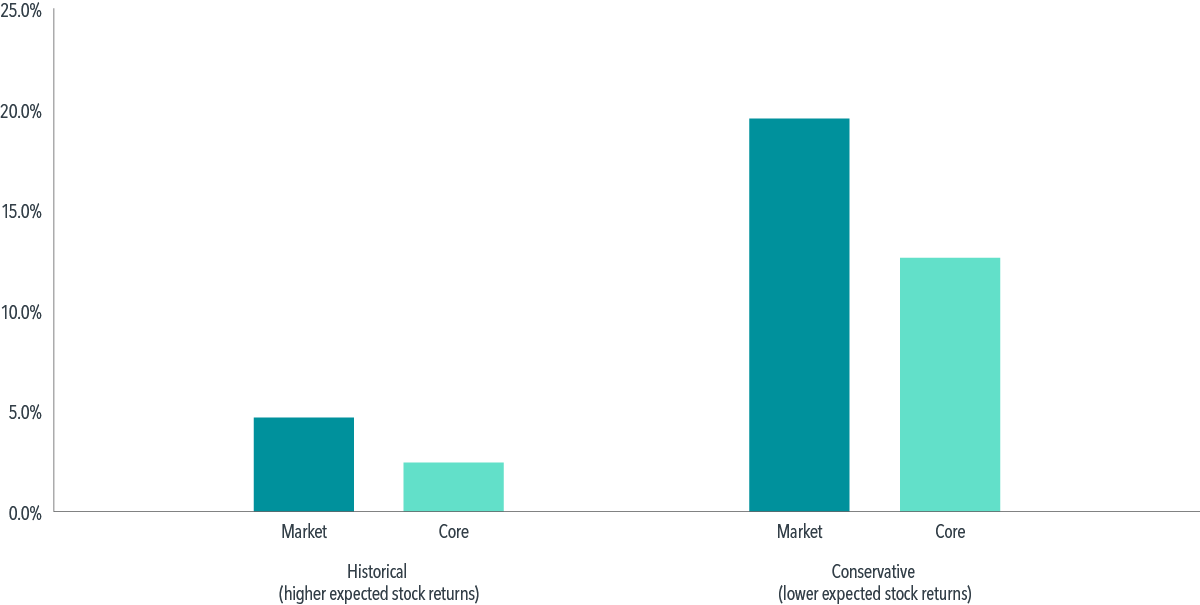
– Broadly diversified equity portfolios with a moderate emphasis on size, value and profitability can help increase retirement assets.
– This investment approach can also sustain retirement income longer and lead to larger bequests.
– The improvement can be achieved at little additional risk compared to market portfolios.
Many retirement investors hold equity portfolios that track broad market indices, either directly or through other investments such as target date funds.
Despite their widespread popularity, market portfolios may leave money on the table.
Core equity portfolios are low-cost, broadly diversified equity portfolios with a moderate emphasis on the size, value, and profitability premiums. They can provide higher expected returns while controlling the risk of underperformance relative to the market.
We examine the benefits of core equity investing for retirement outcomes below:
The benefits start building up in the accumulation phase. Consider two investors who contribute to a retirement account from age 25 to 65 and follow a conventional target date glide path. The equity portion is invested either in a core portfolio or the broad market without any emphasis on the premiums.
Our results show that an investor in the core portfolio will typically reach 65 with 15%–20% more assets than an investor in the plain market portfolio.
The observed benefits of core equity investing continue into retirement.
Going back to our example, let’s assume that both investors retire with a 50/50 split of stocks and bonds and spend a fixed amount every year.
If future stock returns look like past returns, the probability of failure with either portfolio is low (see Exhibit 1), but the core portfolio still does better — and also results in a higher average bequest.
If future stock returns are lower than in the past, failure rates increase across the board. But so does the potential benefit of core equity, which reduces the average failure rate from 20% to 13%.
Here, too, the cost of tracking a market index appears steep; the chance of running out of assets early jumps by 7 percentage points — nearly 54%.
EXHIBIT 1 Premium Rewards
Failure Rates Depending on Premium Exposure in the Equity Sleeve

Of course, these benefits come at the cost of tracking error relative to the market, something that market indexing avoids by definition.
However, our results show that, when it comes to avoiding tracking error, the cure may be worse than the disease.
The study finds that market indexing results in initial retirement assets that are 15% lower on average relative to the core approach. Would you give up an expected 15% of your retirement assets to avoid all tracking error?
Retirement investing involves long investment horizons, which improve the reliability of capturing the premiums and magnify the effect of higher expected returns.
This makes core equity investing an attractive, practical alternative to market indexing — one that can put retirement investors in a stronger position to reach their goals.
Methodology Appendix
We consider a hypothetical investor who retires at age 65 and spends until age 95 according to a 4% spending rule. Retirement spending is 4% of the initial balance at retirement. Spending remains constant in inflation-adjusted terms through retirement. The investor withdraws the spending amount at the beginning of each month. The balance then evolves according to portfolio returns. If the balance amount hits zero, we treat this as a failure.
All the returns used in the simulations are inflation-adjusted using the US CPI.
Portfolio returns are based on a constant, 50/50 split between stocks and bonds. The market portfolio is proxied by the CRSP Deciles 1–10 Index, while the core portfolio is proxied by Dimensional US Adjusted Market 1 Index. Five-year Treasury notes proxy for bond performance. The sample period runs from June 1927 to December 2022.
For each simulated retirement, we draw 30-year (360-month) return histories from our sample. We use block bootstrap with a mean block size of 10 years (120 months) to sample inflation-adjusted annual returns.
We bootstrap returns from the historical distribution and a conservative distribution. The conservative distribution is obtained by subtracting 1.65 times the standard error (1.65 x 1.89% = 3.1%) of the average stock return from the historical average (8.1%). This is equivalent to assuming that the long-run inflation-adjusted equity return is 5.0%, which corresponds to the fifth percentile of the estimated distribution of the average historical return.
The projections or other information generated by bootstrapped samples regarding the likelihood of various investment outcomes are hypothetical in nature, do not reflect actual investment results, and are not guarantees of future results. Results will vary with each use and over time.
Risks
Investments involve risks. The investment return and principal value of an investment may fluctuate so that an investor’s shares, when redeemed, may be worth more or less than their original value. Past performance, including simulated performance, is not a guarantee of future results. There is no guarantee strategies will be successful.
Indices are not available for direct investment; therefore, their performance does not reflect the expenses associated with the management of an actual portfolio.
Diversification does not eliminate the risk of market loss.
Australia
In Australia, this material is provided by DFA Australia Limited (AFSL 238093, ABN 46 065 937 671). It is provided for financial advisors and wholesale investors for information only and is not intended for public use. No account has been taken of the objectives, financial situation or needs of any particular person. Accordingly, to the extent this material constitutes general financial product advice, investors should, before acting on the advice, consider the appropriateness of the advice, having regard to the investor’s objectives, financial situation and needs.





